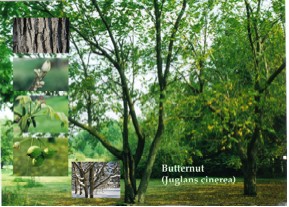"Butternut" "White Walnut" "Oilnut"
| From the Open Files of: | Northwest Synod of Wisconsin Resource Center |
| Contributed by: | Rev. Dr. Loretta Kuse & Dr. Hildegard Kuse |
| This file is available in: Word .doc, .rtf, Picture available in .jpg | |
Walnut Family
"Butternut" "White Walnut" "Oilnut"
(Juglans cinerea)
"Do not be afraid, little flock, for it is your Father's good pleasure to give you the kingdom. Sell your possessions, and give alms. Make purses for yourselves that do not wear out, an unfailing treasure in heaven, where no thief comes near and no moth destroys. For where your treasure is, there your heart will be also. Luke 12:32-34

What do we treasure? Native plants that provide beauty, food, and variety are a treasure.
The Butternut Tree has oval fruit in fall. Squirrels and people compete for it. Squirrels bury this treasure in the ground and hope to find it later and eat it.
It often takes many years before a tree bears nuts. The compound leaves have a long midrib with several leaflets on each side. These trees produce juglone and the leaves should be kept separate from those used for garden compost. Some plants do not grow well near the tree because of this chemical.
Butternut trees have been dying in the United States because of a fungus called butternut canker. Researchers are taking nuts from healthy trees and planting them in areas not affected by the disease. In this way they hope to save this North American treasure tree.
Examine the bark and look at the branching pattern. If a dead tree has been cut down you can count the rings in the stump to determine how old the tree was. Wood from this kind of tree is also highly prized for furniture and carving. Compare the buds of a Butternut Tree with those of a Black Walnut. Butternut buds form more of a peak than those of the rounded Black Walnut.
What does each of us treasure? We have a treasure in heaven. Jesus has come to give us this treasure. We are to also care for the treasures with which we have been entrusted on this earth. We are to care for the trees that God has created.
Dear Lord, Help us to preserve and protect trees – our national heritage and treasure. Help us to also know that we have a treasure in heaven. In your name we pray, Amen.
[ LEAF RAKING DEVOTIONS ] • [ HOME ]
© Copyright 2005 by the Northwest Synod of Wisconsin
Resource Center.
Please see our usage
policy.
NW Synod of Wisconsin Resource Center